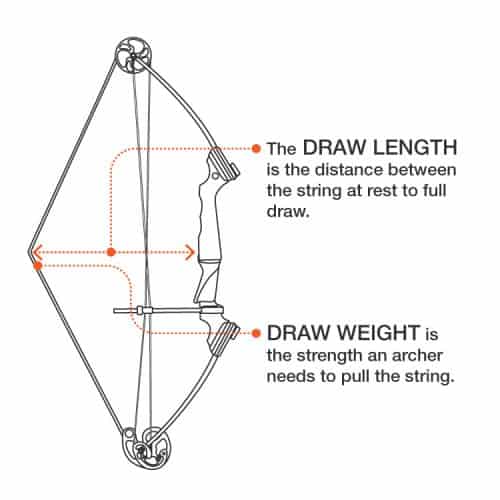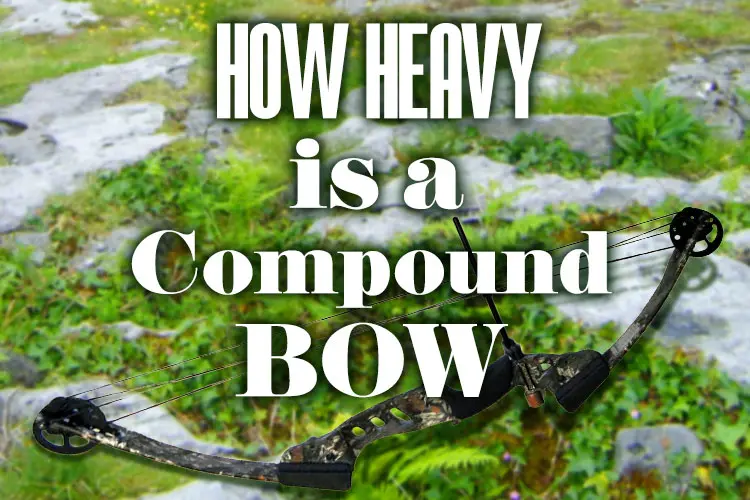[Updated on 1 January 2024] When we talk about bows, the draw weight is always one of the biggest concerns. Draw weight is important, but people rarely talk about the actual weight of the bow, which is more important than you may think. To better know your bow and how it will affect your shot, you should start by understanding how much your compound bow weight with and without attachments.
 So; How heavy is a compound bow? Compound bows without attachments range in size and features, so they range pretty significantly in weight. For the most part, compound bows will weigh as little as three pounds and as much as six pounds. A three-pound difference may not seem like much, but it is enormous, especially with the repetitive motion that comes along with bow hunting. There are a few factors that affect the weight, including the size of the bow and if it is meant as a hunting or competition bow.
So; How heavy is a compound bow? Compound bows without attachments range in size and features, so they range pretty significantly in weight. For the most part, compound bows will weigh as little as three pounds and as much as six pounds. A three-pound difference may not seem like much, but it is enormous, especially with the repetitive motion that comes along with bow hunting. There are a few factors that affect the weight, including the size of the bow and if it is meant as a hunting or competition bow.
How Much Does the Weight Matter?
Table of Contents
The weight of a compound bow matters more than one may think. If your bow is more toward that six-pound mark, you are going to notice the weight right away. The more you use it, the heavier it will get, especially at that weight. Even at the low end, the repetitive movement will start to make a bow feel heavy, which affects your draw speed and your aim.
Unlike a traditional bow, the draw weight does not affect how heavy the bow feels because compound bows are designed to reduce the vibration of the string. Even without the fatigue brought on by stabilizing the bow, it will still cause fatigue after long periods of lifting and lowering your bow. A six-pound bow will even start to feel heavy when you aren’t holding it if you have to carry over long distances like when tracking game.
Is There a Right Compound Bow Weight?
There is no overall perfect weight for a bow; it all depends on how it feels in your hands. Like everything in life, everyone has their personal preference on how much the bow should weigh for comfort and control. There are a few caveats like how a large man may find a three-pound bow too small and light to comfortably use while a smaller child won’t want to start with a six-pound compound bow loaded with add-ons.
Is Tuning My Bow More Important Than Overall Weight?
 For accuracy, tuning is incredibly important, even if it doesn’t affect fatigue as much as it does in a traditional bow. Tuning your bow does affect overall weight in the sense that you should have all your chosen accessories on your bow before you tune it. An untuned crossbow won’t vibrate as much as its traditional counterpart. Still, if it is severely out of tune, it can vibrate as well as cause other underlying issues like arrow accuracy that will weigh on your overall stamina.
For accuracy, tuning is incredibly important, even if it doesn’t affect fatigue as much as it does in a traditional bow. Tuning your bow does affect overall weight in the sense that you should have all your chosen accessories on your bow before you tune it. An untuned crossbow won’t vibrate as much as its traditional counterpart. Still, if it is severely out of tune, it can vibrate as well as cause other underlying issues like arrow accuracy that will weigh on your overall stamina.
How Much Do Attachments Weigh?
All attachments are different, so there is no exact weight, but most accessories fall into a tight weight range. Here are the ranges and functions of some of the more common attachments you will use:
 Stabilizers
Stabilizers
These tiny attachments go on the string and are meant to reduce vibration. They can weigh anywhere from four to ten ounces, but they’re usually on the lower end of that spectrum.
Sights
Sights are a vital part of a bow set up because they help with the accuracy of your shot. It come in a variety of different shapes and sizes, and because of that, they come in a variety of weights. Compound bow sights can weigh anywhere from seven ounces to a pound and a half, but a good portion of them land around nine to eleven ounces.
Rests
Arrow rests are meant to make your arrow fly straighter and improve your concentration. They all have different designs, but most land in the four to the six-ounce range.
With just these few attachments, you can see that it is easy to add a pound or more onto your bow.
Does Bow Weight Affect Competition Status?
Every competition is different, and it is essential to check the rules and regulations of competition before you enter. That being said, the mass weight of the bow is rarely taken into consideration. Competition regulations usually focus on the diameter of the bow. For instance, a protruding sight will not be allowed, so the bow with all of its attachments is required to slide through a ring of a specific diameter, six inches, for example, without touching the sides of the ring.
How Much Does Heavier Bow Weight Affect Hunters?
Hunting is much different than a competition where you can put your bow down before rounds. The weight of your bow can have a significant effect on your accuracy and overall feeling. Hunting may require you to walk for days holding your bow for the entire time. After days of carrying your bow, you may only get one shot at your target, so it is important that your bow feels stable in your hands, and your arms and shoulders are not overly fatigued.
 Unlike in competition, you will not be consistently lifting and lowering your bow, so that is not as big of a concern. However, when you only get one shot at a target and when milliseconds matter, the weight of your bow is important. The lighter the bow, the faster you can lift it to firing level and steady it for a shot.
Unlike in competition, you will not be consistently lifting and lowering your bow, so that is not as big of a concern. However, when you only get one shot at a target and when milliseconds matter, the weight of your bow is important. The lighter the bow, the faster you can lift it to firing level and steady it for a shot.
Is the Bow Material Important?
Bow manufacturers choose the materials they use when making their bows for a reason, so it is important, but weight is probably not their biggest concern. Most materials are chosen to withstand the repetitive use that is implicit in using a bow. The good news is that if your bow uses a lighter material because it is thought to be a more durable option, you can always add attachments to bring the weight up to your comfort level.
Construction of Compound Bow
The riser is the bow’s central mounting point for other components such as limbs, stabilizers, sights, and quivers. Risers are made as rigid as possible to ensure that your structure is stable. The majority of compound bows’ central riser is composed of aluminum, carbon fiber, or magnesium alloy, and many are constructed of 7075 aluminum alloys.
Limbs are composed of fiberglass-based materials and can endure high tensile and compressive strains. All of the energy from a bow is stored in its limbs, which are devoid of pulleys and cables. Adult compound bows typically have draw weights of 40 to 80 pounds (18 to 36 kg), with arrow speeds of 250 to 370 feet per second (76 to 113 m/s).
At the end of each limb, there is either a cam or a wheel. The form of the cam varies somewhat from bow to bow. There are several distinct types of bow eccentrics, and they all fall under the term bow eccentrics. The four most common bow eccentric are Single Cam, Dual Cam, Hybrid Cam, and Binary Cam. There are a few unusual designs available, such as the Quad Cam and Hinged. The let-off rating of cams is often used to describe them. The amount of force required to maintain the bow in place as it is rotated rises and then gradually decreases as the bow approaches maximum extension (also known as “the wall”). The difference between the maximum force encountered during the draw and the force required to keep the bow in full extension is known as “let-off.” The percentage of peak draw strength is a general guideline for all compound bows. However, it may vary considerably depending on the design and manufacturer. Some older compound bows had a let-off of only 50%, while some recent designs have let-offs of over 90%.
Other Things to Consider When Thinking About Bow Weight
Does Arrow Weight Matter?
Arrow weight absolutely matters, especially for accuracy. Arrow weight affects arrow speed, the drop rate over distance, and how deep the arrow penetrates the target. Also, arrow penetration is especially important when hunting. Much like with finding the bow weight you are comfortable with; finding the right arrow weight for your needs may take some trial and error.
How Do I Prevent Fatigue?
There are two great ways to prevent fatigue in the future. The first is through consistent, repetitive use of your bow. The more you use your bow, the more those muscles will build the stamina needed to prevent fatigue. The second way to avoid fatigue in the future is to lift low weights at high reputations to train muscle stamina.
Can You Lighten the Mass Weight of a Compound Bow?
The simple answer is no. While compound bows do have a few moving parts, they are rarely interchangeable; and if they are, it is nearly impossible to find lighter pieces.
Is This The Same for a Crossbow?
Crossbows are very different from traditional and compound bows. Most of this information will be different than it will be for a crossbow.
The Final Say
There is no perfect answer for how heavy a compound bow is because they are all different from their base weight to the added weight of various attachments. Choosing the right weight for a compound bow comes down to trial and error. Just remember that weight is not the most critical factor in the end.
Frequently Asked Questions(FAQs)
What is the highest draw weight for a compound bow?
The most powerful production compound bow was designed by PSE and featured a draw weight of 100 pounds. Bows that are more readily available usually have a maximum draw weight of 80 pounds, as determined by the producers.
How far will a 40 lb bow shoot?
The effective range of 40 lb bow is 25-30 yards.
Is 50 lb draw weight enough?
40 pounds of kinetic energy is enough to efficiently kill whitetails, while 50 pounds or more is required for a bigger game such as elk, moose, or bear.



 Stabilizers
Stabilizers




15 Comments
Pingback: Diamond Deploy SB Compound Bow - Boss Targets
Pingback: Bowtech BT-X Compound Bow - Boss Targets
Pingback: Diamond Edge SB-1 Compound Bow
Pingback: Bowtech Prodigy Compound Bow
Pingback: Bear Cruzer Compound Bow - Boss Targets
Pingback: Bear Attitude Compound Bow - Boss Targets
Pingback: Bear Escape Compound Bow - Boss Targets
Pingback: Bear Cruzer vs Diamond Infinite Edge - Boss Targets
Pingback: PSE Brute Force Compound Bow - Boss Targets
Pingback: SAS Outrage Compound Bow - Boss Targets
Pingback: Diamond Infinite Edge Pro Compound Bow - Boss Targets
Pingback: What is the Ideal Draw Weight for My Bow?
Pingback: Best Beginners Bow & Archery Style? - Boss Targets
Pingback: Compound or Recurve Bow – Which one is Best and Why?
Pingback: Useful Crossbows fundamentals for Hunters and Target Shooters